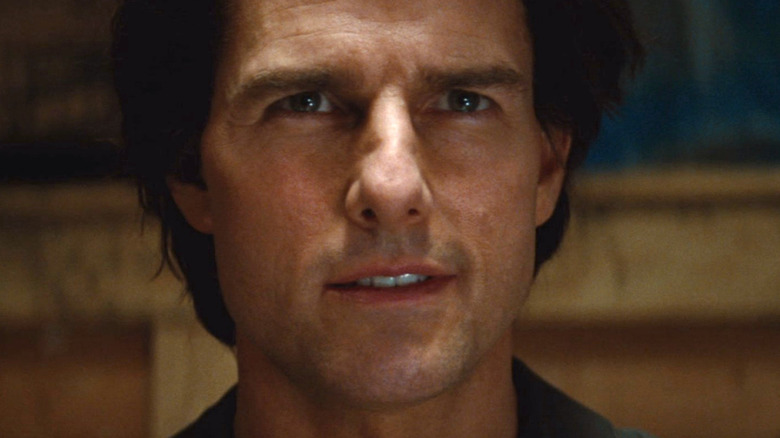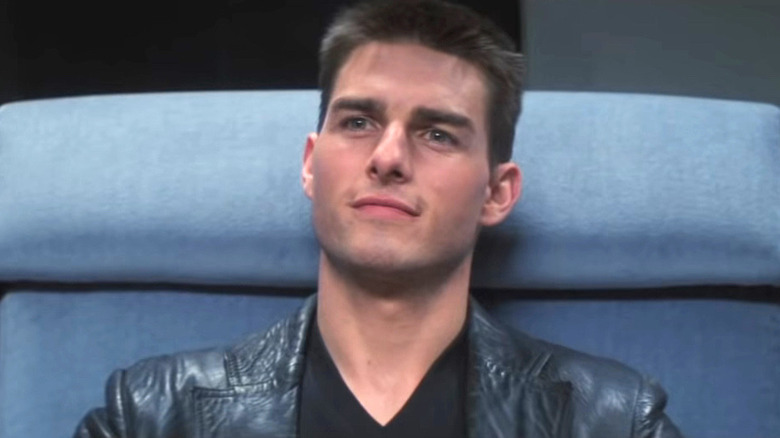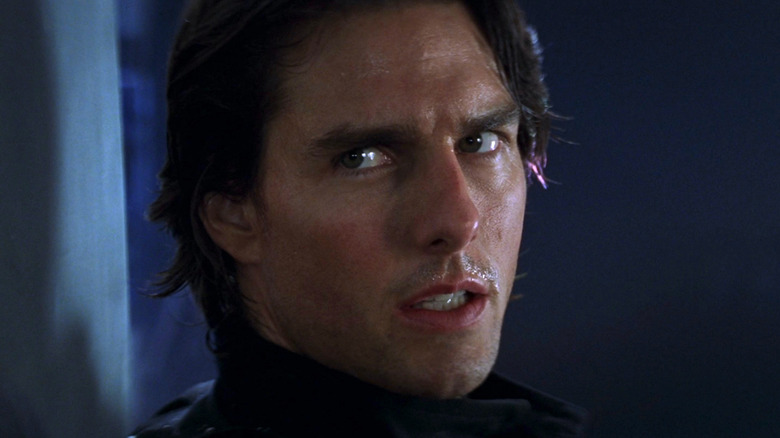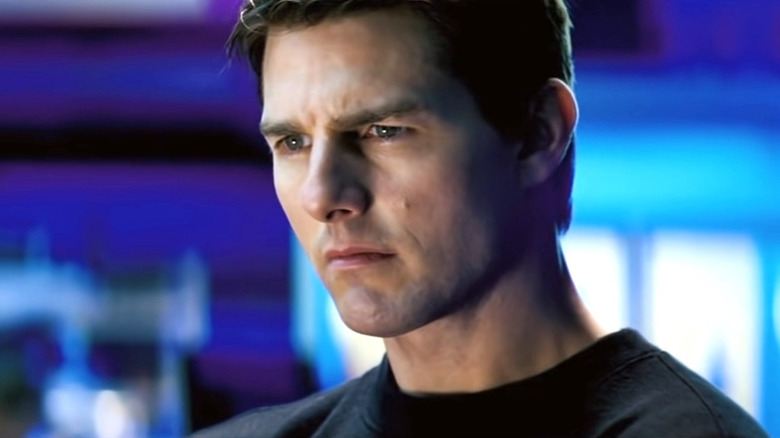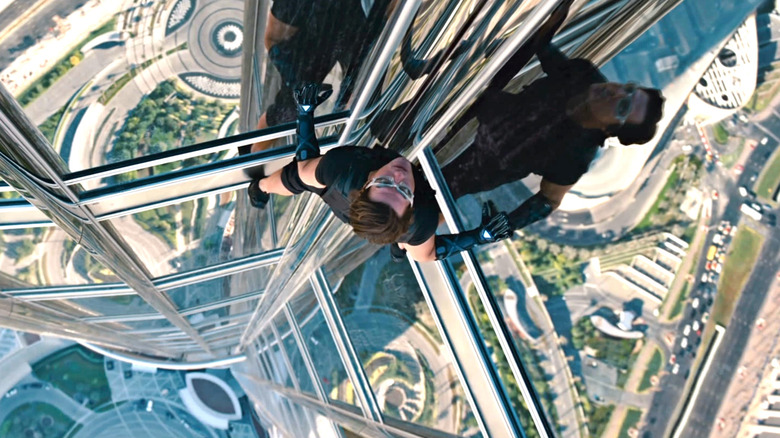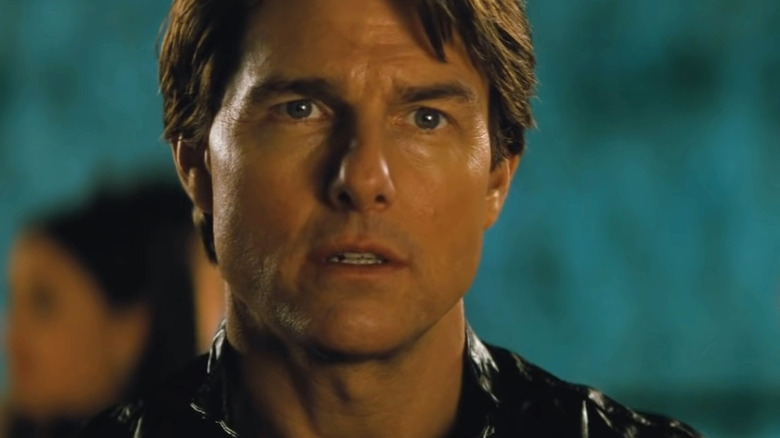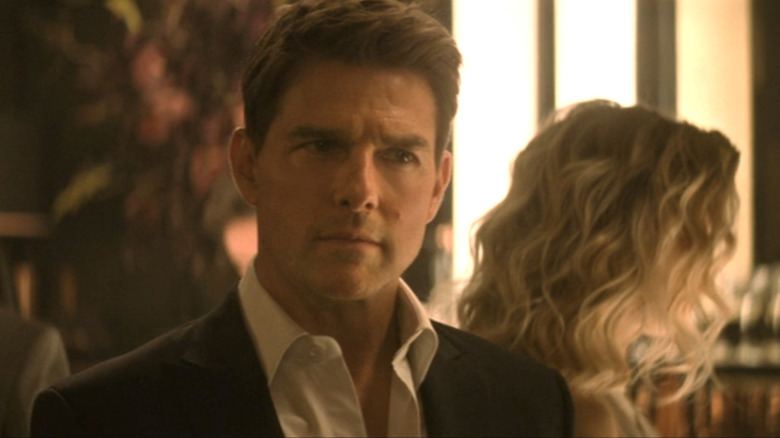The Correct Order To Watch The Mission: Impossible Franchise
There aren't many film franchises nowadays that are more well-known or beloved than "Mission: Impossible." The Tom Cruise-led film series, which is based on the 1966 TV show of the same name, is on the verge of releasing not only its seventh installment but also its eighth. That'd be seen as an undeniable achievement for any film franchise, but seems like a particularly special one when it comes to "Mission: Impossible," which released its first installment all the way back in 1996.
Over the years, directors like Brian De Palma, Brad Bird, and Christopher McQuarrie have all brought their own perspectives to the "Mission: Impossible" series. In addition to Cruise, who has led every "Mission: Impossible" movie to date, the franchise has also gradually built an impressive rotating cast of supporting players. However, while that means the "Mission: Impossible" franchise has the ability to assemble a new ensemble for each of its installments, the ever-changing nature of the series' cast can also make it difficult for new viewers to fully get their heads around the ongoing story and adventures of Cruise's Ethan Hunt.
With that in mind, here's the correct order in which viewers should watch the "Mission: Impossible" movies.
Mission: Impossible (1996)
It all began back in 1996. That's the year "Mission: Impossible," the Brian De Palma-directed, loose continuation of Bruce Geller's iconic TV series, was released in theaters. The beloved thriller also marks Tom Cruise's screen debut as Ethan Hunt, the Impossible Mission Force agent that he has gone on to play an additional five times to date.
While the "Mission: Impossible" film franchise has evolved quite a bit in the years since its 1996 debut installment was released, De Palma's big-screen thriller set the tone and laid the groundwork for everything that has come after it. Based on a script written by David Koepp and Robert Towne, the film follows Cruise's Ethan Hunt as he is forced to uncover the identity of the secret double agent working within the very organization he's dedicated his life to supporting.
With De Palma at the helm, "Mission: Impossible" makes a lasting impact as a pulse-pounding spy thriller that features more than its fair share of now-iconic set pieces. That includes a covert infiltration of CIA headquarters, which remains one of the "Mission: Impossible" franchise's most memorable action sequences. For that reason and more, this 1996 thriller remains a strong entry point into the "Mission: Impossible" franchise.
Mission: Impossible 2 (2000)
Coming four years after the release of its predecessor, 2000's "Mission: Impossible 2" takes place after the events of 1996's "Mission: Impossible." Unlike the latter film, though, "Mission: Impossible 2" was not directed by Brian De Palma, but by acclaimed Hong Kong action filmmaker John Woo. The film, consequently, not only looks and feels different than the "Mission: Impossible" franchise's first installment, but it also moves at a far different rhythm and pace.
Starring "Westworld" alum Thandiwe Newton, the 2000 film follows Tom Cruise's Ethan Hunt as he teams up with a professional thief (played by Newton) in order to locate and destroy a dangerous, genetically modified disease. The disease in question just so happens to be in the possession of a former Impossible Mission Force agent (played by Dougray Scott) that Newton's thief once dated.
The "Mission: Impossible" films that have followed this Woo-directed entry have referenced it a surprisingly small number of times, and it remains one of the franchise's lesser-beloved movies. However, it deserves to be seen not only for its handful of truly memorable action sequences but also so that the full breadth of Ethan Hunt's espionage adventures isn't ever lost on "Mission: Impossible" viewers.
Mission: Impossible 3 (2006)
This 2006 installment in the "Mission: Impossible" franchise is narratively one of the series' most important. Picking up years after the events of its 2000 predecessor, "Mission: Impossible III" finds Tom Cruise's Ethan Hunt living a happy life in the suburbs with his fiancée, Julia Meade (Michelle Monaghan). Ethan is pulled back into active spy duty, however, when he's asked to rescue a former protégé. That mission sets off a series of events that force Ethan into a head-to-head battle with Owen Davian (Philip Seymour Hoffman), a dangerous arms dealer.
As is usually the case with the "Mission: Impossible" franchise, this J.J. Abrams-directed blockbuster is a thrilling piece of spy-centric entertainment. Beyond that, the film introduces several characters and storylines, including Ethan's relationship with Julia, that have since been referenced and revisited multiple times in the "Mission: Impossible" movies that have followed it. In other words, of all of the franchise's early films, "Mission: Impossible III" is undoubtedly the one that's worth watching before moving on to any of the series' subsequent installments.
Mission: Impossible — Ghost Protocol (2011)
Following the release of "Mission: Impossible III," the "Mission: Impossible" franchise took a five-year break. The series made an impactful return, however, when "Mission: Impossible — Ghost Protocol" was released in theaters in December 2011. Directed by "The Incredibles" and "Ratatouille" filmmaker Brad Bird, "Mission: Impossible — Ghost Protocol" picks up several years after "Mission: Impossible III" and finds Tom Cruise's Ethan Hunt actively working again as a field agent for the Impossible Mission Force.
After Ethan fails to prevent a dangerous attack overseas, the film follows him and the members of his latest team as they are forced to go without their usual resources or governmental support on a mission to both save the world and rescue the IMF's oft-maligned reputation. Outside of its thrilling plot, "Mission: Impossible — Ghost Protocol" is likely best known for its centerpiece action sequence, which follows Cruise's Ethan as he literally scales the outside of the world's tallest building, the Burj Khalifa in Dubai.
The sequence in question, notably, marks the beginning of a new era for the "Mission: Impossible" franchise, one in which the series' installments are more often remembered for their jaw-dropping practical stunts than they are for their plots or characters. That fact alone makes it one of the more important entries in the ongoing "Mission: Impossible" franchise.
Mission: Impossible — Rogue Nation (2015)
Unlike "Mission: Impossible — Ghost Protocol," which directly references the events of its predecessor, 2015's "Mission: Impossible — Rogue Nation" functions as one of its franchise's more standalone entries. Directed by Christopher McQuarrie, "Mission: Impossible — Rogue Nation" opens with an awe-inspiring sequence in which Tom Cruise's Ethan Hunt is forced to hold onto the outside of a cargo plane as it takes off into the air. From there, the film ultimately follows him on yet another twisty, complicated spy adventure.
Outside of its memorable stunt sequences, "Rogue Nation" is perhaps most well-known for introducing not only Solomon Lane (Sean Harris), who ranks as one of the "Mission: Impossible" franchise's most noteworthy villains, but also Ilsa Faust (Rebecca Ferguson), the MI6 agent who quickly became one of the series' biggest, fan-favorite characters. Additionally, while "Mission: Impossible — Rogue Nation" bears very few major connections to the films that have come before it, the film's story does directly lead into the plot and events of 2018's "Mission: Impossible — Fallout."
That, in other words, makes this 2015 outing yet another "Mission: Impossible" film that must be watched before its sequel in order for any possible confusion to be avoided.
Mission: Impossible — Fallout (2018)
Directed by Christopher McQuarrie, "Mission: Impossible — Fallout" picks up shortly after the events of "Mission: Impossible — Rogue Nation" and follows Tom Cruise's Ethan Hunt as he is forced to break his most recent foe, Solomon Lane (Sean Harris), out of his prison in order to track down three plutonium cores that have fallen into the wrong hands.
Along the way, Ethan teams up with August Walker (Henry Cavill), a formidable CIA assassin, and finds himself coming face-to-face again with figures from his past, like Ilsa Faust (Rebecca Ferguson) and his former fiancée, Julia Meade (Michelle Monaghan). "Mission: Impossible — Fallout" also, notably, features some of its franchise's biggest action sequences to date, including a high-octane chase through the streets of Paris, a death-defying helicopter chase, and a practical high altitude—low opening (HALO) jump out of a cargo plane.
In addition to its impactful stunts and character reunions, "Fallout" also happens to be the most recent "Mission: Impossible" film to date, which means it's the latest chapter in the series' ongoing story. In other words, once first-time viewers watch this 2018 thriller, all they'll have left to do is go back and rewatch the "Mission: Impossible" franchise's past installments while they wait for its next entries to be released.
